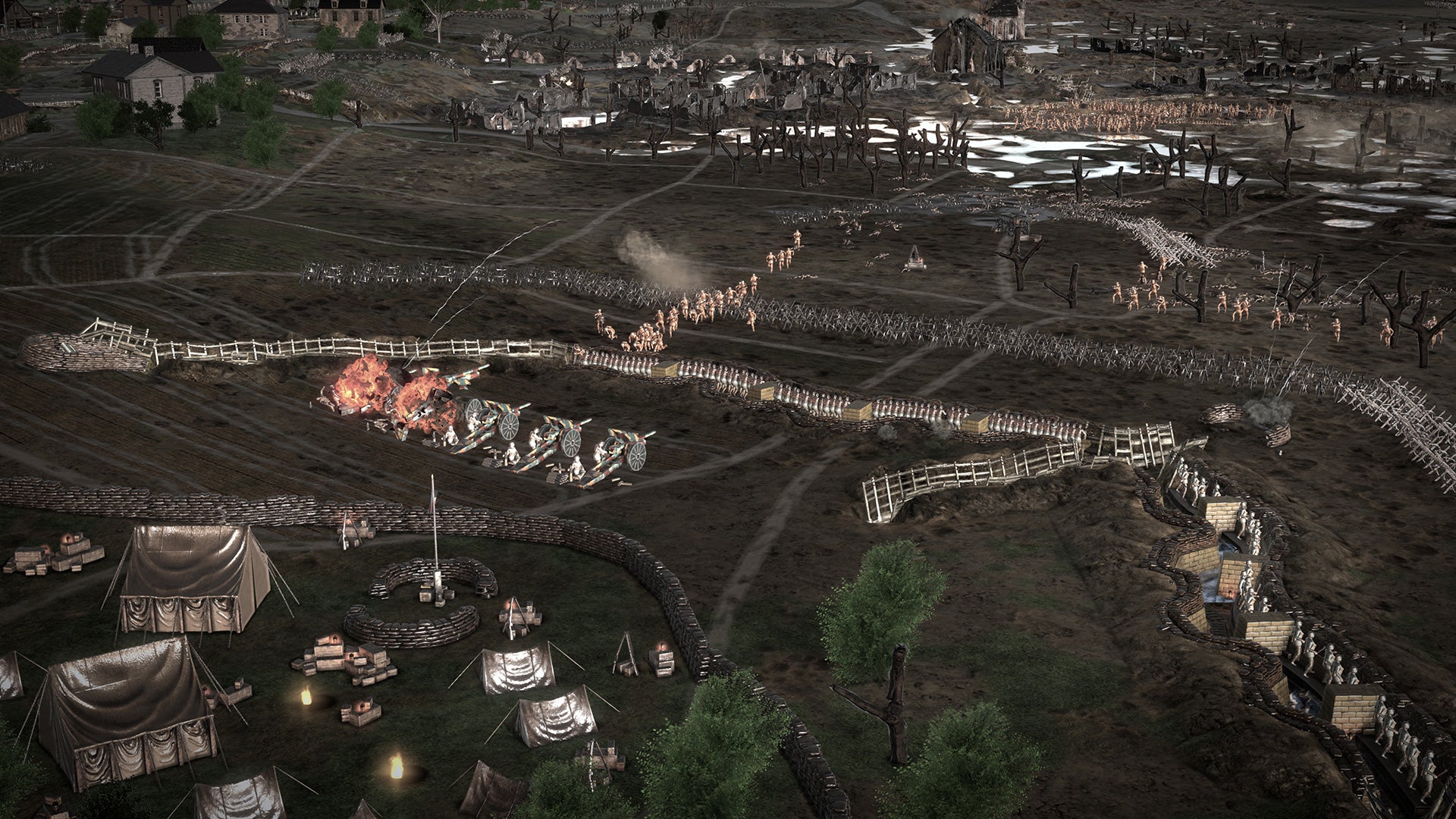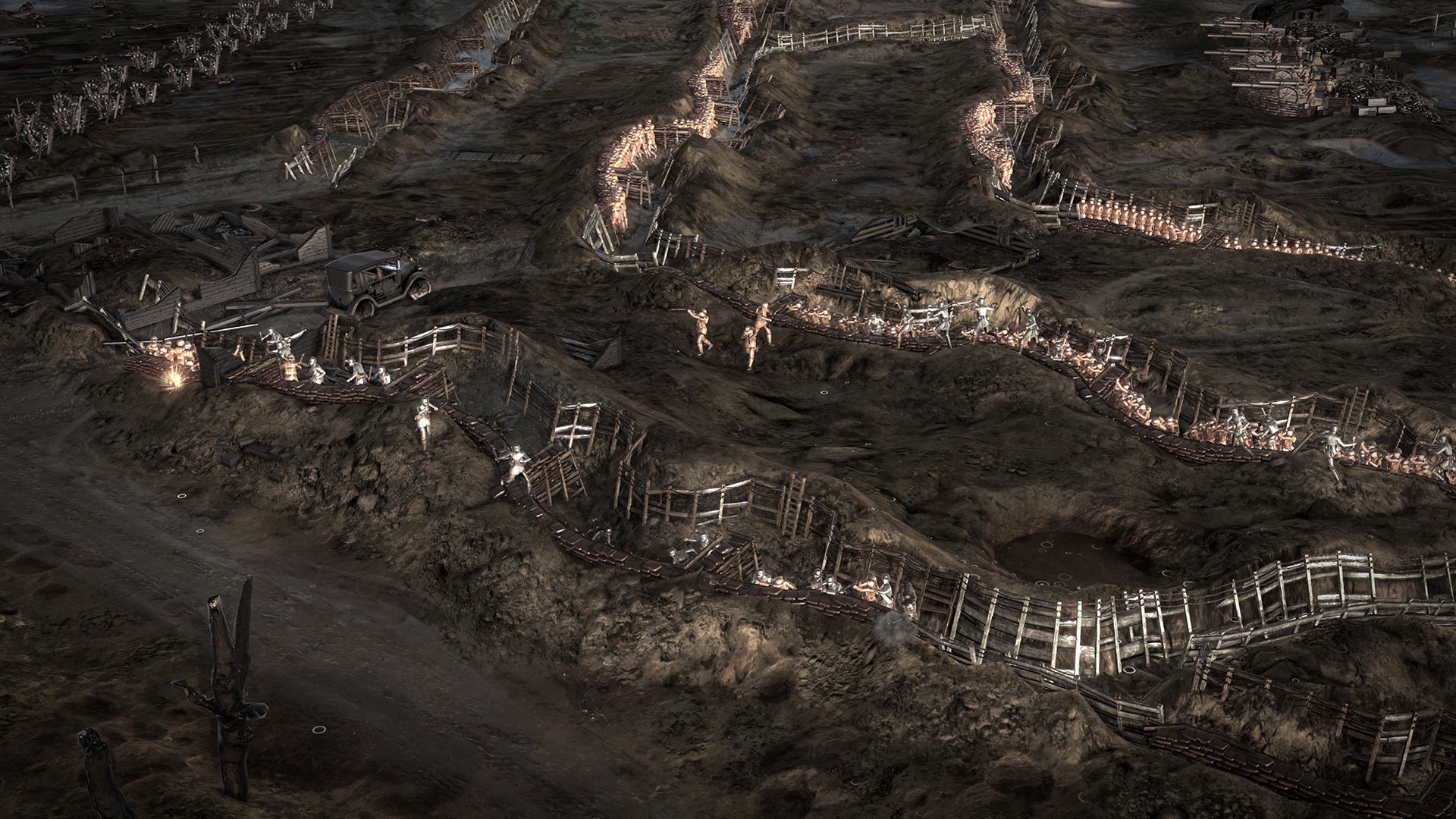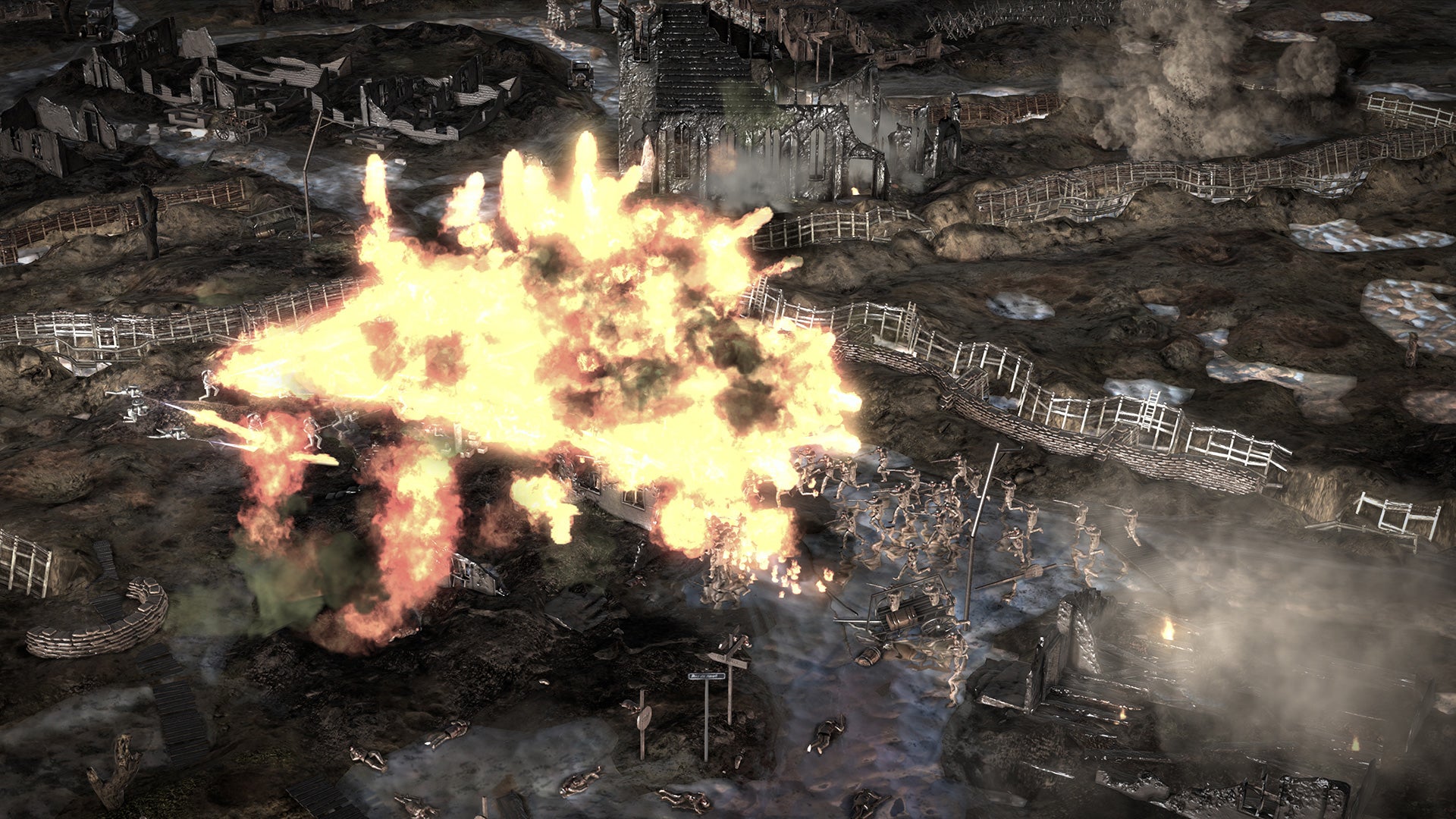In some ways, this shouldn’t be surprising. As Petroglyph Games’ lead designer Chris Becker tells me over email, “WW1 is known for being a war of attrition and a battle of inches,” leading to fewer sweeping power plays when it comes to securing a victory. Indeed, your main concern here isn’t so much the winning of each individual battle, but maintaining your side’s National Will, which Becker says will be “in constant fluctuation” throughout the campaign – and with both the Allies and Central Powers to pick from here, that could mean very different things depending on who you choose. “It’s essential that players continue to monitor this, as the relentless toll that the war will take on National Will can result in overall victory or defeat,” says Becker. “Authenticity is at the heart of this, we wanted to truly represent what ‘victory’ meant in the war - even with success, there is cost.” I found this out the hard way during my playthrough of the Battle of Passchendaele. Right at the top of the screen, for example, there’s a bar showing the likely outcome of the battle at hand, ranging from Major Defeat, Minor Defeat, Stalemate, Victory and so on. At the start of the mission, this bar was roughly around the halfway mark, signalling a stalemate, but even as I began making progress with the mission’s main objectives, it began falling closer and closer toward defeat due to all the casualties I’d accumulated in the process. I eventually found a good rhythm of calling down rolling barrages to provide essential cover fire for my troops as they made their way across the perilous, muddy torrents of No Man’s Land to capture enemy trenches, but not before I’d lost several companies to the German’s oncoming streams of deadly machine gun fire. You can, of course, call up more troops to replace them, but you’ll need to balance these funds with the cost of ammunition. Moreover, these resources don’t auto regenerate over time like they do in Company Of Heroes, so you’ll need to manage them carefully to secure that first time victory. It’s a delicate balancing act, and one I eventually misjudged as I reached the mission’s climax. Indeed, with no more soldiers to call on, and no more of that all-important barrage cover fire to support my remaining troops, the only option left to me was to call a full-scale retreat. And I don’t just mean retreat back to the nearest outpost, a la Company Of Heroes. I mean full-on surrender and ceding the victory. This might sound counterintuitive for an RTS, but it’s something Petroglyph will be actively encourage players to do for the sake of their National Will, as calling it a day before things get too messy might still let you claim what they’re calling a ‘Marginal Victory’ instead of a full one. “During each battle, in the role of Field Commander the player can see the tide of the battle and gauge the potential outcome,” Becker explains. “As an attacker, the player can cease fire at any time, while as the Defender, the player can surrender (ceding total victory, but preventing casualties and preserving resources). This is a key balance for players to consider – the cost vs. the outcome – not just for themselves, but also their enemy. On defense, this allows the player to take a losing position with the intent of making it as costly as possible to the enemy.” Alas, I was very much the attacker in the Battle of Passchendaele, with the main thrust of the mission focused on capturing enemy trench lines in order to make a run at their stronghold sitting at the top of the map. The first point of capture was a set of trenches directly in front of me – a simple enough task once I’d got my rolling barrages in order to act as cover for my ant-like troop companies. With my bird’s eye view of the battlefield, it’s easy to know what should be done to get to your next goal. The hard part, naturally, is figuring out an effective plan of attack. To take that first line of trenches, for example, I ordered my soldiers into the weakest, least defended part of the trench and watched them get to work, dropping in and filing down its arteries to rid them of their current occupants. They did all this without much prompting on my part, although I did have to direct them to dispatch a few remaining stragglers that weren’t in their immediate eyeline. With my new foothold established, the next task was capturing two flanking trench lines to execute a pincer attack on the main German defences – a challenging prospect that involved not just ridding them of their fog-of-war-lifting reconnaissance balloons, but also dealing with barbed wire, more machine gun posts, and some rather large, hoofing cannons. I spent a lot of manpower acquiring those flanks, but the Germans didn’t just sit idly by and let me have them. When I was running low on manpower to keep them defended, I caught the AI making its own recapture plays for them on a couple of occasions, suggesting you’re going to need to keep up the pressure if you’re looking to claim that full, definitely not marginal victory. That said, if that pressure means sacrificing your all-important National Will, even that might be a fool’s errand when all is said and done. “The type of combat WW1 is known for doesn’t easily fit the expectations of a typical RTS,” says Becker. “In most RTS titles, victory is fairly decisive, you win or you lose. In The Great War, all battles have a scale that directly impacts the course of the campaign. Even when you ‘win’ there is a cost of attrition – the player has to replace troops and the casualties will impact their National Will. This means the player has to constantly weigh up the resources they’re committing in pursuit of victory. For example, if you’ve got only a small number of infantry in a particular region, it might be more beneficial to call a halt after repelling an enemy offensive, rather than pushing back.” The idea, says Becker, is all about trying to capture that sense of realism, letting players “make decisions that reflect historical accuracy”. However, he also says players will be able to “forge their own path and experiment with different strategies as well,” harking back to the game’s tagline of being able to ‘relive’ history, or ‘redefine it’. As for how you can go about redefining the history of WW1, Becker says the tech tree, story events and even the tactics you employ in the Theatre Commander mode can all end up altering the course of the game’s campaign. I didn’t get to see any of these in action during my short playthrough session unfortunately, but from what Becker tells me, it will be the tech tree that forms the backbone of its historical reinvention. Unlocked by spending tech points you accrue over the course of the campaign, Becker says “the pace of the tech points is set to be historically authentic,” allowing players to progress their war technology in line with what was available at the time. However, they’ll also be able to plug those points into different pathways, allowing, say, the Central Powers to focus on air superiority tech earlier on in the war. “How would that cascade through the years of the war?” Becker posits. “What would have changed?” Again, my hands on time with The Great War was solely focused on the Passchendaele battle, so it’s hard to tell right now how far-reaching these consequences will be over the course of a campaign. Still, it certainly sounds promising, and should hopefully provide plenty of nuance for repeat playthroughs. If you’d rather not meddle with the order and authenticity of the game’s technology tree, though, Becker says that even the way you choose to build your trenches will provide ample opportunity for tackling different strategies as your campaign progresses. Again, this wasn’t available during my demo, owing to Passchendaele being a ‘Historic Battle’ where trenches are preset to stay in-keeping with the setting. However, Becker assures me players will still be able to build their own trenches in other battles present in the campaign, as well as its multiplayer and Skirmish modes. The placement of those trenches becomes even more important when you realise you’ll be revisiting these battlegrounds for a second, third, and maybe even fourth time (or more) depending on what kind of victory you’re able to achieve there. To ‘win’ a region, Becker says territories will have Star Levels that represent “how worn down they are”, and it’s only when all those stars are removed by claiming a total victory in its RTS battles that you’ll be able to claim it for yourself. “In addition to that, stars regenerate each turn when the territory is not attacked, but any territories that are involved in combat will receive fatigue penalties,” Becker explains. “This encourages the player to develop long term strategies across multiple turns, and engage in battles to soften territories before going in for total victory.” Trench placement will be key to this, as they persist across multiple battles in the same region. You know, as trenches tended to do in WW1. Crucially, though, this doesn’t mean you’ll just be replaying the same old maps over and over again. Indeed, Becker tells me you’ll be able to upgrade your trenches with extra protection, or use long-range artillery in that pre-battle phase to straight up remove them from play. As a result, battlefields and their respective trenches will be “more and more complex throughout the campaign,” say Becker, changing in ways that means players “will not recognize the battlefield they first fought on”. At the same time, though, he’s hoping that enduring sense of familiarity with its maps will also open up newer, more efficient strategies along the way, allowing players to “push for greater victories at a lower cost” to help keep that National Will bar in check. “The focus here is on ownership,” says Becker. “The player owns their progression through the decisions they make throughout the campaign, which is primarily measured in National Will. […] Effectively the player is in a race to not reach the bottom first, keeping National Will strong by achieving calculated success.” It’s this comprehensive approach to real-time tactics that Becker and the rest of the team at Petroglyph hopes will make The Great War: The Western Front stand out against its more explosive WW2 rivals next year, and what will keep players coming back for repeat campaigns. I may have only seen a tiny snippet of this WW1 RTS so far, but my will for this to succeed has never been higher.



